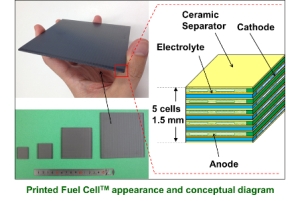Oct 8 2013
FCO Power Inc. today announced the development of a next-generation solid oxide fuel cell (SOFC). The Printed Fuel Cell™ achieves high volumetric power density – 3 kW/L – at low cost.

Printed Fuel Cell™ features
The Printed Fuel Cell™(below)is a SOFC stack in which all single cell layers, including separators (anode, electrolyte, cathode, and ceramic separator) are laminated repeatedly before sintering and subsequently simultaneously sintered only once as a stack.
The Printed Fuel Cell™ does not require a cell support because it does not need to maintain mechanical strength as single cell unit. As a result, the total thickness of a single cell and separator is just 0.3 mm, which is approximately one tenth the thickness of conventional technology. Because it is so thin, the Printed Fuel Cell™ achieves 3 kW/L, which is the highest level in the world, and significantly surpasses the New Energy and Industrial Technology Development Organization (NEDO)’s stack power density target for 2020 to 2030, which is 0.4 to 1 kW/L according to NEDO’s fuel cell and hydrogen technology road map for 2010.
Additionally, the Printed Fuel Cell™ has a simple, thin laminated structure that requires a limited amount of material and parts, making it suitable for low-cost, automated mass production. As a result, FCO Power expects to be able to price the Printed Fuel Cell™ at a level that is well below NEDO’s target stack price of JPY 50,000 /kW for 2020 to 2030.
Leveraging this high volumetric power density and low cost, FCO Power aims to commercialize the Printed Fuel Cell™ around 2018 to 2020 with a focus on application in limited spaces, such as in apartments for home use, and for distributed power use in offices and factories, which require significant cost efficiency.
This technology will be presented at the 13th International Symposium on Solid Oxide Fuel Cells on October 9, 2013, in Okinawa, Japan.
SOFC background
Among the several types of fuel cell available, SOFCs are expected to become especially widely used because of their higher power generation efficiency and ability to operate with a diverse variety of gases, including renewable biogas. However, reducing the cost of fuel cells, especially SOFC stacks, is a major issue for broad application. FCO Power’s Printed Fuel Cell™ now solves the cost issue.
FCO Power Inc.
FCO Power is a SOFC start-up focusing on SOFC stacks, founded on October 1, 2010. In 2005, its predecessor, FCO Co., Ltd., started joint research and development around next-generation SOFC stacks with Japan Fine Ceramics Center, a leading ceramics institution. From 2008, activities were accelerated with support from the University of Tokyo Edge Capital, one of the leading technology venture capital investors in Japan.
Currently, FCO Power is participating in NEDO’s “New Energy Venture Business Technology Innovation Program 2013”. The company has participated in several other innovation projects including one led by Japan’s Ministry of Economy, Trade and Industry.